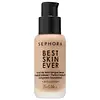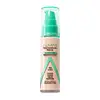What's inside
What's inside
 Key Ingredients
Key Ingredients

 Benefits
Benefits

 Concerns
Concerns

 Ingredients Side-by-side
Ingredients Side-by-side

Water
Skin ConditioningDimethicone
EmollientCI 77891
Cosmetic ColorantIsohexadecane
EmollientPEG-10 Dimethicone
Skin ConditioningPropanediol
SolventAlcohol
AntimicrobialCI 77492
Cosmetic ColorantDimethicone Crosspolymer
Emulsion StabilisingAcrylates Copolymer
Glycerin
HumectantMagnesium Sulfate
Synthetic Wax
AbrasiveCI 77491
Cosmetic ColorantHydroxyacetophenone
AntioxidantDisodium Stearoyl Glutamate
CleansingDisteardimonium Hectorite
StabilisingCI 77499
Cosmetic ColorantCaprylyl Glycol
EmollientSodium Hyaluronate
HumectantPropylene Carbonate
SolventAluminum Hydroxide
EmollientHydrolyzed Algin
Helianthus Annuus Seed Oil
EmollientPhenethyl Alcohol
MaskingSodium Carrageenan
Emulsion StabilisingGlyceryl Stearate Citrate
EmollientTocopherol
AntioxidantAscorbyl Tetraisopalmitate
AntioxidantBeta-Sitosterol
Emulsion StabilisingSqualene
EmollientMaris Sal
Skin ConditioningWater, Dimethicone, CI 77891, Isohexadecane, PEG-10 Dimethicone, Propanediol, Alcohol, CI 77492, Dimethicone Crosspolymer, Acrylates Copolymer, Glycerin, Magnesium Sulfate, Synthetic Wax, CI 77491, Hydroxyacetophenone, Disodium Stearoyl Glutamate, Disteardimonium Hectorite, CI 77499, Caprylyl Glycol, Sodium Hyaluronate, Propylene Carbonate, Aluminum Hydroxide, Hydrolyzed Algin, Helianthus Annuus Seed Oil, Phenethyl Alcohol, Sodium Carrageenan, Glyceryl Stearate Citrate, Tocopherol, Ascorbyl Tetraisopalmitate, Beta-Sitosterol, Squalene, Maris Sal
Water
Skin ConditioningCyclopentasiloxane
EmollientGlycerin
HumectantCyclohexasiloxane
EmollientNylon-12
Trimethylsiloxysilicate
EmollientPEG/PPG-18/18 Dimethicone
EmulsifyingDimethicone
EmollientCetyl PEG/PPG-10/1 Dimethicone
EmulsifyingBoron Nitride
AbsorbentIsodecyl Neopentanoate
EmollientCopernicia Cerifera Cera
EmollientSalicylic Acid
MaskingAloe Barbadensis Leaf Juice
Skin ConditioningMaris Sal
Skin ConditioningAlpha-Glucan Oligosaccharide
CleansingCaprylyl Glycol
EmollientDimethicone/Bis-Isobutyl PPG-20 Crosspolymer
EmollientHydrolyzed Vegetable Protein
Skin ConditioningLactobacillus
Skin ConditioningLecithin
EmollientMaltodextrin
AbsorbentPEG-10 Dimethicone
Skin ConditioningPerlite
AbsorbentPolymnia Sonchifolia Root Juice
Skin ConditioningTetrasodium EDTA
Tocopheryl Acetate
AntioxidantTriethoxycaprylylsilane
Trisiloxane
Skin ConditioningPhenoxyethanol
PreservativeIron Oxides
CI 77492
Cosmetic ColorantCI 77499
Cosmetic ColorantCI 77891
Cosmetic ColorantZinc Oxide
Cosmetic ColorantWater, Cyclopentasiloxane, Glycerin, Cyclohexasiloxane, Nylon-12, Trimethylsiloxysilicate, PEG/PPG-18/18 Dimethicone, Dimethicone, Cetyl PEG/PPG-10/1 Dimethicone, Boron Nitride, Isodecyl Neopentanoate, Copernicia Cerifera Cera, Salicylic Acid, Aloe Barbadensis Leaf Juice, Maris Sal, Alpha-Glucan Oligosaccharide, Caprylyl Glycol, Dimethicone/Bis-Isobutyl PPG-20 Crosspolymer, Hydrolyzed Vegetable Protein, Lactobacillus, Lecithin, Maltodextrin, PEG-10 Dimethicone, Perlite, Polymnia Sonchifolia Root Juice, Tetrasodium EDTA, Tocopheryl Acetate, Triethoxycaprylylsilane, Trisiloxane, Phenoxyethanol, Iron Oxides, CI 77492, CI 77499, CI 77891, Zinc Oxide
 Reviews
Reviews

Ingredients Explained
These ingredients are found in both products.
Ingredients higher up in an ingredient list are typically present in a larger amount.
Caprylyl Glycol is a humectant and emollient, meaning it attracts and preserves moisture.
It is a common ingredient in many products, especially those designed to hydrate skin. The primary benefits are retaining moisture, skin softening, and promoting a healthy skin barrier.
Though Caprylyl Glycol is an alcohol derived from fatty acids, it is not the kind that can dry out skin.
This ingredient is also used as a preservative to extend the life of products. It has slight antimicrobial properties.
Learn more about Caprylyl GlycolCi 77492 is also hydrated iron III oxide. It's sole purpose is to give a yellow hue to products.
Iron III oxides are classified as inorganic chemicals for coloring.
Synthetically created Ci 77492 is considered safer than those naturally found. This is because the synthetically created version may contain less impurities. Iron oxides are generally non-toxic and non-allergenic.
Learn more about CI 77492Ci 77499 is also hydrated iron III oxide. It is created from mixing red and black iron oxides. This helps give shades of darkness to a product.
Iron III oxides are classified as inorganic chemicals for coloring.
Ci 77891 is a white pigment from Titanium dioxide. It is naturally found in minerals such as rutile and ilmenite.
It's main function is to add a white color to cosmetics. It can also be mixed with other colors to create different shades.
Ci 77891 is commonly found in sunscreens due to its ability to block UV rays.
Learn more about CI 77891Dimethicone is a type of synthetic silicone created from natural materials such as quartz.
What it does:
Dimethicone comes in different viscosities:
Depending on the viscosity, dimethicone has different properties.
Ingredients lists don't always show which type is used, so we recommend reaching out to the brand if you have questions about the viscosity.
This ingredient is unlikely to cause irritation because it does not get absorbed into skin. However, people with silicone allergies should be careful about using this ingredient.
Note: Dimethicone may contribute to pilling. This is because it is not oil or water soluble, so pilling may occur when layered with products. When mixed with heavy oils in a formula, the outcome is also quite greasy.
Learn more about DimethiconeGlycerin is already naturally found in your skin. It helps moisturize and protect your skin.
A study from 2016 found glycerin to be more effective as a humectant than AHAs and hyaluronic acid.
As a humectant, it helps the skin stay hydrated by pulling moisture to your skin. The low molecular weight of glycerin allows it to pull moisture into the deeper layers of your skin.
Hydrated skin improves your skin barrier; Your skin barrier helps protect against irritants and bacteria.
Glycerin has also been found to have antimicrobial and antiviral properties. Due to these properties, glycerin is often used in wound and burn treatments.
In cosmetics, glycerin is usually derived from plants such as soybean or palm. However, it can also be sourced from animals, such as tallow or animal fat.
This ingredient is organic, colorless, odorless, and non-toxic.
Glycerin is the name for this ingredient in American English. British English uses Glycerol/Glycerine.
Learn more about GlycerinWe don't have a description for Maris Sal yet.
Peg-10 Dimethicone is silicone with conditioner and emulsifier properties. It mostly acts as an emollient in skincare and and humectant in haircare.
According to the manufacturer, acidic formulations decrease the stability of this ingredient. It works best in neutral or near neutral formulations.
Water. It's the most common cosmetic ingredient of all. You'll usually see it at the top of ingredient lists, meaning that it makes up the largest part of the product.
So why is it so popular? Water most often acts as a solvent - this means that it helps dissolve other ingredients into the formulation.
You'll also recognize water as that liquid we all need to stay alive. If you see this, drink a glass of water. Stay hydrated!
Learn more about Water